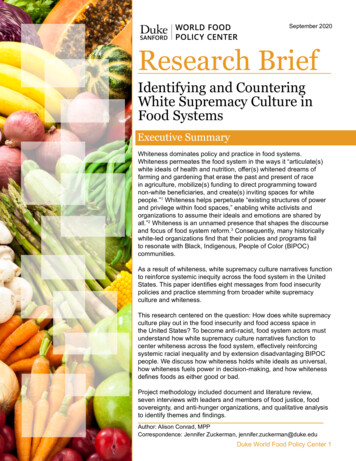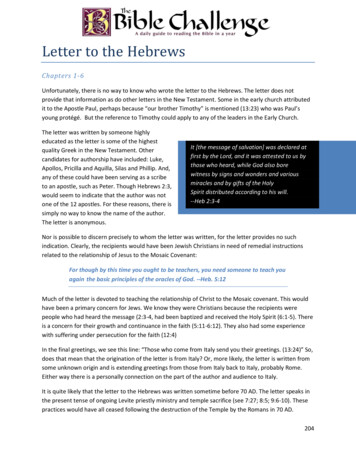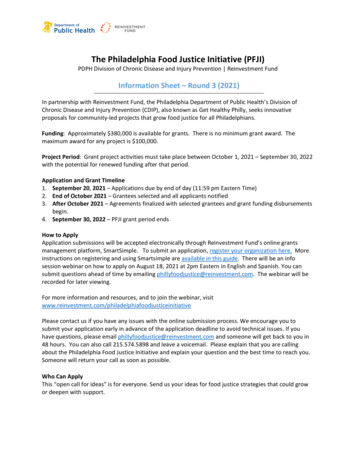
Transcription
September 2020Research BriefIdentifying and CounteringWhite Supremacy Culture inFood SystemsWhiteness dominates policy and practice in food systems.Whiteness permeates the food system in the ways it “articulate(s)white ideals of health and nutrition, offer(s) whitened dreams offarming and gardening that erase the past and present of racein agriculture, mobilize(s) funding to direct programming towardnon-white beneficiaries, and create(s) inviting spaces for whitepeople.”1 Whiteness helps perpetuate “existing structures of powerand privilege within food spaces,” enabling white activists andorganizations to assume their ideals and emotions are shared byall.”2 Whiteness is an unnamed presence that shapes the discourseand focus of food system reform.3 Consequently, many historicallywhite-led organizations find that their policies and programs failto resonate with Black, Indigenous, People of Color (BIPOC)communities.As a result of whiteness, white supremacy culture narratives functionto reinforce systemic inequity across the food system in the UnitedStates. This paper identifies eight messages from food insecuritypolicies and practice stemming from broader white supremacyculture and whiteness.This research centered on the question: How does white supremacyculture play out in the food insecurity and food access space inthe United States? To become anti-racist, food system actors mustunderstand how white supremacy culture narratives function tocenter whiteness across the food system, effectively reinforcingsystemic racial inequality and by extension disadvantaging BIPOCpeople. We discuss how whiteness holds white ideals as universal,how whiteness fuels power in decision-making, and how whitenessdefines foods as either good or bad.Project methodology included document and literature review,seven interviews with leaders and members of food justice, foodsovereignty, and anti-hunger organizations, and qualitative analysisto identify themes and findings.Author: Alison Conrad, MPPCorrespondence: Jennifer Zuckerman, jennifer.zuckerman@duke.eduDuke World Food Policy Center 1
WhitenessAnti-RacismWhiteness is a “powerful social construction with veryreal, tangible, violent effects.”4 Whiteness is not justa reference to skin color, but is an ideology “basedon beliefs, values, behaviors, habits and attitudes,which result in the unequal distribution of powerand privilege based on skin color.”5 Whiteness isoften invisible to those who benefit from it, but hasimmense power: “The power of whiteness, however,is manifested by the ways in which racializedwhiteness becomes transformed into social, political,economic, and cultural behaviour. White culture,norms, and values in all these areas becomenormative natural. They become the standard againstwhich all other cultures, groups, and individuals aremeasured and usually found to be inferior.”6Anti-racism is the “work of actively opposing racismby advocating for changes in political, economic,and social life.”13 It starts at the individual level,with individuals working against their own or other’sracist behaviors and impacts. It can also be at theorganizational level, with organizations reevaluatinginternal policies and processes to be explicitly antiracist, as well as organizations working to counteractracist behaviors and cultures in the systems in whichthe organization operates and actively seeks to decenter whiteness and shift power within the system.White Supremacy CultureWhite supremacy culture is the “idea (ideology) thatwhite people and the ideas, thoughts, beliefs, andactions of white people are [inherently] superior toPeople of Color and their ideas, thoughts, beliefs,and actions.”7 It “justifies and binds together theUnited States white supremacy system” and is“reproduced by all the institutions of our society.”8White supremacy culture is “powerful preciselybecause it is so present and at the same time sovery difficult to name or identify.”9 Society holdscharacteristics of white supremacy culture as thenorms and standards, promoting white supremacythinking. As a result, attitudes and behaviorsstemming from white supremacy culture can be foundin any individual, group, or organization, whether it iswhite-led or predominantly white-led, BIPOC-led, orhas a predominantly BIPOC staff.10BIPOCBIPOC stands for “Black, Indigenous, People ofColor.” The term is “meant to unite all people ofcolor in the work for liberation while intentionallyacknowledging that not all people of color face thesame levels of injustice.”11 The BIPOC term separatesBlack and Indigenous individuals from People ofColor in the United States to recognize that “Blackand Indigenous people face the worst consequencesof systemic white supremacy, classism and settlercolonialism.”122 Research BriefRacial EquityRacial equity is the “condition that would beachieved if one’s racial identity no longer predicted,in a statistical sense, how one fares.”14 Racialequity is a component of racial justice and involves“work to address root causes of inequities not justtheir manifestation,” including the “elimination ofpolicies, practices, attitudes and cultural messagesthat reinforce differential outcomes by race or fail toeliminate them.”15Structural RacismStructural racism is the most pervasive form ofracism and basis for all other forms of racism(internalized, institutional, interpersonal, etc.). It isthe “normalization and legitimization of an arrayof dynamics – historical, cultural, institutional andinterpersonal – that routinely advantage whiteswhile producing cumulative and chronic adverseoutcomes for people of color.”16 Furthermore,structural racism “encompasses the entire system ofwhite domination, diffused and infused in all aspectsof society including its history, culture, politics,economics and entire social fabric.”17 It is not easyto locate within any one institution because “itinvolves the reinforcing effects of multiple institutionsand cultural norms, past and present, continuallyreproducing old and producing new forms ofracism.”18For a more comprehensive list of definitions,visit https://www.racialequitytools.org/glossaryand premacy-culture.html.
Identifying and Countering White Supremacy Culture in Food SystemsWhite supremacy culture is inherent in the way individuals, organizations, and governmentsdiscuss the food system and in what ideals the same groups uphold as normative. Some whitesupremacy culture narratives include defensiveness, perfectionism, “only one right way” thinking,and quantity over quality.19 All these narratives create oppressive cultures in organizations,perpetuating white supremacy and feeding into systems that hold whiteness and white ideals asthe default. White supremacy culture and whiteness are pervasive across systems, including thefood system. As such, broader white supremacy culture narratives show up in food policies andprograms, as detailed below.IndividualismNeoliberalismIndividualism stresses the needs of theindividual over the needs of the group as awhole. Individualism emphasizes that peopleshould be able to solve problems or accomplishgoals on their own. In the food space,individualism translates to a focus on helpingindividuals who have fallen on hard times overstructural issues contributing to food insecurityand hunger.62Neoliberalism is an ideology and policy modelthat emphasizes replacing entitlements withmarket-based solutions to social problems andplaces value on free market competition. In thefood space, neoliberalism is rooted in Americanideals of personal responsibility and hard workas the solution to hunger and that it is theresponsibility of communities to care for those inneed, not government.65,66PaternalismUniversalismPaternalism involves interfering in an individual’sor community’s ability or opportunity to chooseand make decisions. It has the objective ofimproving welfare of individuals or communitiesand involves making decisions without theconsent of the individuals or communitiesconcerned. In the food space, paternalismfocuses on the belief that BIPOC communitiescannot take care of themselves and needsolutions prescribed to them.63,64Universalism assumes that values held bywhites are normal and widely shared, meaningideals are grounded in whitened culturalpractices. Universalism results in a lack ofresonance of these universal ideals andmarginalization of those who do not conform tothe ideals. Furthermore, it creates a narrativethat the non-conforming must be educated onthe ideals.67 In the food space, universalismmeans whiteness fuels and dominates theconversation on how and why the food systemshould be reformed, with organizations buildingprojects and programming around their whitenedassumptions.68 As a result, food spaces are“shaped by a set of white cultural practices” that“can inhibit the participation of people of colorin alternative food systems, and can constrainthe ability of those food systems to meaningfullyaddress inequality.”69Duke World Food Policy Center 3
White supremacy culture narratives show up in many forms and exist throughout policy, programming,and practice. They permeate how we talk about issues in the food system, in campaigns for foodsystem reform, and in the day-to-day operations of many organizations. This research brief provides anintroduction as to how white supremacy culture narratives play out specifically in the food system.Figure 1: Intersection of White Supremacy Culture Narratives and Food System Narratives“If they only knew” focuses on lack of understanding on the part of the individual and need for education, suchas healthy food and cooking classes, as opposed to structural problems, such as inequities in food accessand affordability and economic drivers of food insecurity.20 This narrative is an example of individualism,boiling down issues of healthy eating to individual behavior choices, as well as an example of paternalism,assuming that the decision maker or organization knows more or better than the individual.21,22 “If they onlyknew” also reflects the white supremacy narrative of universalism because the organization/decision makergets to determine what is “good food,” which is often steeped in whiteness and ignores non-white culturalinfluences on food.EXAMPLE4 Research BriefSupplemental Nutrition Assistance Program Education (SNAP-Ed). SNAP-Ed is aprogram aimed at helping “people lead healthier lives” through teaching “people usingor eligible for SNAP about good nutrition and how to make their food dollars stretchfurther.”23 It also teaches participants about physical activity. These types of programsfocus on nutrition education as the way to become healthier, disregarding knowledgeparticipants might already have and avoiding focusing on larger structural forces that canimpact healthy behaviors.24,25
Identifying and Countering White Supremacy Culture in Food Systems““[Education puts] the focus on the people who live in these [food desert]neighborhoods and not on the systems that have impacted the people who livein these neighborhoods.– Leader of a food sovereignty organization26“Vote with your fork” is the belief that your consumption will signal your values in the food system. This ignoresstructural forces dictating who can access and afford foods and what foods are upheld as “ideal” or “good.”This narrative is steeped in individualism and neoliberalism, focusing on individual actions and consumption inthe market as the way to signal preferences for healthier, more sustainable food and force companies to shiftpractices.27“In the last 10-20 years, environmental and agricultural sustainability campaignshave driven the idea of “eating for change” and “voting with your fork.”28 The focus ofthese campaigns has the intent of addressing structural issues, such as dismantlingfactory farming and industrial meat production, ending the exploitation of labor, andreducing meat consumption. However, “vote with your fork” leaves out individuals andcommunities without purchasing power to “participate” in agricultural sustainabilitycampaigns that rely on individual acts of consumption.29 It reinforces the idea thatenvironmental sustainability is only valued and shown through individual purchases,and those that are not purchasing, must not believe in eating consciously, locally, andethically.The notion that the food system can be transformed through individualacts of consumption—rather than through lobbying, organizing, boycotts,mobilization, or direct action—fits nicely within the prevailing neoliberaleconomic rhetoric: that unregulated capitalist markets yield the most efficientallocation of resources.– Eric Holt-Giménez and Yi Wang, 201130“EXAMPLE“Communities can’t take care of themselves” is a paternalistic, societal narrative that communities andindividuals—especially BIPOC individuals and individuals living in low-income neighborhoods—cannot takecare of themselves and therefore are lazy, undeserving, and need to be helped.31 It is based in negativeracial and class stereotypes and reinforces inequitable power dynamics in the food system, with outsideorganizations and decisionmakers coming into BIPOC and low-income communities and deciding what is bestfor them. In the food space, this narrative reproduces inequitable power dynamics, centering the conversationaround white ideals for solving issues in the food system. As a result, the narrative renders racial historiesinvisible and ignores structural inequalities driving food insecurity in BIPOC and low-income communities.32EXAMPLEMobile produce markets. Mobile produce markets are initiatives aimed at addressing“food deserts” by bringing fresh produce into communities via a van, or mobile market.However, such projects often involve white-led institutions coming into communitiesthat are predominantly BIPOC, low-income, or both. As a result, institutions come intocommunities to solve the “food desert” issue, with philanthropy and funders providing themoney to white-led institutions instead of directly investing in communities or fundingDuke World Food Policy Center 5
projects led by BIPOC community members, creating a power imbalance in funding anddecision making. White-led institutions are granted the funding to “solve” communityissues, directly supporting the salaries and infrastructure of white led non-profits insteadof investing directly in the community.33 Consequently, mobile produce markets canadvocate for improved access to affordable, fresh, and healthy foods, but they take apaternalistic approach by disregarding community assets and opportunities to supportcommunity ownership of food security initiatives.““[People believe that] the Black community is deficient and at risk and canonly survive by the donations and benevolence of white-led corporations andnonprofits and even government entities and municipalities.– Leader of a food sovereignty organization34“Failure to listen” occurs when organizations do not trust or listen to the BIPOC communities they aim to serveand ignore the community’s ability and power to self-determine solutions for themselves. This narrative is aresult of paternalism, in which the organization coming into the community assumes they know better thancommunity members and thus prescribes solutions for them. It also reflects universalism, assuming BIPOCcommunities are monolithic and that all BIPOC people would want “best practice” solutions determinedby predominantly white institutions with predominantly white cultural framing. A failure to listen can resultfrom inequitable power dynamics, with organizations and governments leaving BIPOC and low-incomecommunities out of conversations on food movements, policy creation, and decision making.35,36,37 Forexample, a review of 13 community food organizations in the Northeast found that: 84 percent of leadershippositions were held by white persons and only 11 percent of board members were people of color.38 Becauseorganizations lack the representation of BIPOC communities where food system’s work occurs, voices ofBIPOC individuals and communities “remain almost invisible” in the work.39EXAMPLE“Video - “Food insecurity proposal causes frustration on Indy’s northeast side.”40 Foodinsecurity and “food deserts” (a misnomer, more accurately reflected as “food apartheid”41acknowledging the systemic disinvestment in a specific area) are major issues acrossthe country, with many state and local governments trying to figure out how to betterconnect residents with healthy, affordable foods. However, as shown in the video, localgovernments failed to acknowledge the community-led solution to food access that wasalready in place in northeast Indianapolis. As opposed to listening to the community andinvesting in community assets, the local government proposed solutions that extractwealth from the neighborhood, taking community dollars to other areas of the city.The issue of participation is often raised, framed as something that can beremedied by conducting “outreach” or building a more “inclusive” project thatbetter engages local residents. In this article I argue that efforts for “inclusion”in community food projects will continue to struggle to build participation incommunities of color if they do not shift the power structures that exist withinthe organization itself.— Margaret Marietta Ramirez, 201542“6 Research Brief
Identifying and Countering White Supremacy Culture in Food SystemsA “build it and they’ll come” approach focuses on establishing a food retail venue as the solution to foodissues and centers the conversation solely on food access, rather than on structural causes of food accessissues.43,44 This narrative is an example of paternalism, where organizations and/or governments attempt tobring in large, corporate food businesses rather than investing in existing, local avenues of food procurementand wealth building. Furthermore, communities are often not given the opportunity to weigh in on whatfood retail they would like, creating a power imbalance in decision making. As a result, extractive policies,such as tax breaks to large, corporate, food retailers to incentivize supermarket placement, are imposed oncommunities and local solutions are disregarded and inadequately invested in.EXAMPLE Healthy Food Financing Initiative (HFFI). HFFI was based on successful state-basedfood financing initiatives that focus on supermarket access as the determinant for foodaccess and subsequent purchases of healthy foods. HFFI continues to frame “fooddeserts” in terms of spatial distance to supermarkets and food access as the majordeterminant of healthy eating and health outcomes. However, research shows thatopening supermarkets in “food deserts” does not result in people buying healthierfoods.45“ interest in food enterprises and projects has more recently been used todistance many communities from their power, becoming instead a trendto be capitalized on, with public and private investments in grocery storedevelopment, vertical farming, meal delivery kits, or commercial shared-usekitchens - projects with many positive outcomes but that can often exclude lowincome residents, are imposed on communities with little input, and contributeto land loss and gentrification, and loss of community identity and cohesion.—EFOD Collaborative, 201946““Pull yourself up by your bootstraps” is rooted in the belief that people need to take personal responsibility andwork harder to get out of hunger and poverty. It is a classic neoliberal narrative, pathologizing the individual,highlighting the exceptional individuals who succeed in spite of “the odds” and focusing on individual behaviorand work ethic as keys to economic prosperity. This narrative dismisses structural and institutional barriers47,48to economic advancement that systemically disadvantage predominantly BIPOC people and communities.EXAMPLE Personal Responsibility and Work Reconciliation Act of 1996. The Act, signed byPresident Clinton, substantially reformed welfare in the United State, in an attemptto “end the dependence of needy parents on government benefits by promoting jobpreparation, work, and marriage.”49 As noted by the name, the Act emphasized anarrative of personal responsibility and working hard as the solutions to poverty and toshrink reliance on the government by “needy parents.”Duke World Food Policy Center 7
““Since the 1990s, policymakers have been selling the “bootstraps” myththat if poor people go to work, they can escape poverty. The reality isthat women who left welfare for low-wage work in the 1990s foundlittle relief from the grinding poverty they had known when they wereon assistance Tying welfare benefits like cash and food assistance toan obligation to work will always produce hunger and poverty in theabsence of a commitment to full employment.— Maggie Dickinson and Megan A. Carney, 201950Charity solutions to hunger are rooted in the idea that hunger is an individual responsibility issue andtherefore the solution to hunger is providing food. Alternately, a food justice approach would address thestructural reasons that created a system where significant hunger is so prevalent.51,52 This narrative fitsunder the broader idea of neoliberalism which led to the dismantling of federal food assistance programsand proliferation of food banks. It also has elements of individualism, as food charity provides food on anindividual/household level rather than addressing poverty or other root causes of hunger.EXAMPLE Since the inception of food assistance programs, political narratives around thedeservingness of the poor for government assistance have plagued the programs,especially in regards to SNAP.53 SNAP has been under near constant attack, withpoliticians and governments attempting to restrict access through stringent workrequirements and eligibility criteria. Such efforts increase the difficulty for households toenroll and stay enrolled in SNAP. As the government enacts cuts to the social safety net,the “moral responsibility to care for the most vulnerable among us is being transferredfrom government to private charity,” as seen through the existence of over 60,500emergency food providers in the United States.54 The shift from government to charityhas served to limit the solution to hunger to food distribution, instead of addressingstructural factors of hunger, such as poverty and economic inequality.55““Pathologizing language and imagery are used to pull at the heart stringsof citizens and to motivate charitable food donations. These stories portrayhunger as a significant problem that can be solved by individuals ‘doing good,’when in reality, the hunger problem is far too vast to be solved by charity.— Rebecca de Souza, 201956White dominant culture determines which foods are “good” or “bad”, ignoring the cultural significance ofcertain foods or insinuating that some foods are bad because of cultural or racial associations.57 The idea ofcalling some foods good or bad is rooted in universalism. White dominant culture serves as the basis of the“universal” ideals regarding what foods are “good” or “bad” for a healthy diet, removing culturally appropriatefoods from traditional diets. By attributing universal ideals about what is good or bad food, the whitenedcultural ideal of good food erases the cultural histories of non-white traditions and eating habits. Furthermore,whiteness glosses over the historical context and racism related to changing eating patterns, ignoring howcolonialism and industrialism stripped away indigenous farming practices and foods and violently pushedcommunities of color away from farming and agriculture by forcing them off their land.588 Research Brief
Identifying and Countering White Supremacy Culture in Food SystemsEXAMPLE Kale vs. collard greens. Kale and collard greens are nutritionally equivalent, but the whitedominant culture holds kale as a “good food,” while collards are “virtually absent from thefood discourse.”59 In contrast, the same culture associates collards with poor Southernersand Black Americans and a negative, anti-black, and racist association of collards withlarge amounts of pork lard and salt.60 Kale is seen as a “good food,” while the equallynutritious collard greens are not, resulting in the removal of culturally appropriate foodsfrom the “good food” discourse.“ vast systems of white supremacy and colonial regimes of power andknowledge have [led] to an erasure and devaluation of contributions ofindigenous people and cultures. Directions to ‘eat healthy’ commonly invoke theMediterranean Diet, for example. The cultural effect is that [ ] we are taughtthe Greco-Roman diet in our food education, ignoring and erasing all othermodels. Research has shown that when people embrace traditional diets ofnon-European peoples—such as Native Hawaiian, rural South African, TohonoO’odham, or Aboriginal Australian—their health improves.– Catriona Rueda Esquibel, 201661“To work against white supremacy narratives, organizations must make explicit changes in operations,policies, and practice. However, organizational shifts require individuals to do the internal work to recognizeand unwind white supremacy narratives within themselves. White supremacy narratives, racism, whiteness,and microaggressions will still show up in your work and your organization without individual learning andconsistent attention. We offer the following questions and resources to begin your individual work in this spaceor continue to expand your learning:Research how racism, anti-blackness and white supremacy are built into the food system,in particular in your local and community food system.Ask yourself: What inequities exist in the food system? How do these impact food insecurity and hunger rates inthe United States? Whose labor and land was used to create the American agricultural system? What historical policies have contributed to food access, affordability, and insecurity issues in yourcommunity?Understand that “colorblindness” is not real—society and the food system are not raceneutral spaces.Ask yourself: What is the racial and class composition of the food spaces I frequent? Why are these spacesdominated by certain groups? Who is repackaging non-white traditional and cultural food practices and earning money andattention based on those practices?Duke World Food Policy Center 9
Pay attention to how whiteness has influenced your experiences in the food system.Ask yourself: How many grocery stores do you have access to in your community and who owns them? How hard is it for me to find and afford culturally appropriate foods at the grocery stores I do haveaccess to? How difficult would it be for me to get capital to start a food or agricultural business?Think through who holds the decision-making power in the food system and who benefitsfrom the actions of those decision makers and institutions.Ask yourself: Who sits in positions of power and leadership at your organization or at other food organizations?How many BIPOC individuals are in these positions? How many are people from the communityyou are seeking to help involved in co-creation of programming? Who most benefits from policy, programming, and capital decisions in the food space? Are thesebenefits equitably distributed? Why or why not? When we make recommendations or best practices, whose best practices are we uplifting?General LearningWhat is Systemic Racism? Video Series by Race ForwardThinking Critically about Racism, Whiteness, and Class by Showing Up for Racial JusticeResource List from Racial Equity ToolsA History: The Construction of Race and Racism from Racial Equity ToolsBook ListsThe Anti-Racist Reading List by Ibram X. Kendi in The AtlanticA Reading List For Learning About Anti-Black Racism and Food by Emily Johnson and the Editors ofEpicuriousA Food Justice Reading List from the University of California Press22 Noteworthy Food and Farming Books for Summer Reading in 2018—and Beyond from Civil EatsBooksBlack Food Geographies: Race, Self-Reliance, and Food Access in Washington, D.C. by Ashanté M. ReeseFeeding the Other: Whiteness, Privilege, and Neoliberal Stigma in Food Pantries by Rebecca de SouzaCultivating Food Justice: Race, Class, and Sustainability by Alison Hope Alkon and Julian AgyemanFood Justice by Richard Gottlieb and Anupama JoshiReportsApplying a Racial Equity Lens to End Hunger by Marlysa Gamblin et al for the Bread for the World InstituteClosing the Grocery Store Gap in the Nation’s Capital report by DC Hunger SolutionsThe US Farm Bill: Corporate Power and Structural Racialization in the US Food System by Hossein Ayazi andElsadig Elsheikh for the UC Berkeley Othering & Belonging InstituteJournalismHow the Rise of Supermarkets Left Out Black America by Nathaniel Meyersohn for CNN BusinessRetail Redlining: One of the Most Pervasive Forms of Racism Left in America? by Emily Badger forBloomberg CityLabHow Black Communities Are Bridging the Food Access Gap by Nadra Nittle for Civil EatsWant to See Food and Land Justice for Black Americans? Support These Groups by the Civil Eats EditorsCollards vs. Kale: Why Only One Supergreen Is a Superstar by Rebekah Kebede for National Geographic10 Research Brief
Identifying and Countering White Supremacy Culture in Food SystemsArticlesAn Annotated Bibliography on Structural Racism Present in the U.S. Food System, Seventh Edition by RachelKelly et al for the Center for Regional Food Systems at Michigan State UniversityThe Color of White Supremacy: Beyond the Discourse of ‘White Privilege’ by Zeus Leonardo“If They Only Knew”: Color Blindness and Universalism in California Alternative Food Institutions by JulieGuthmanWhiteness and Farmers Markets: Performances, Perpetuations Contestations? by Alison Hope Alkon andChristie Grace McCullenThe Elusive Inclusive: Black Food Geographies and Racialized Food Spaces: Black Food Geographies andRacialized Food Spac
the ability of those food systems to meaningfully address inequality."69 Neoliberalism Neoliberalism is an ideology and policy model that emphasizes replacing entitlements with market-based solutions to social problems and places value on free market competition. In the food space, neoliberalism is rooted in American










